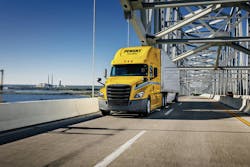2027 Prebuy strategies: How fleets can prepare before regs kick in
After 20 years in the making, when 2027 model-year trucks hit the road, they will be equipped with technology that meets the most significant changes in emissions regulations since 2010.
Due to the widespread expectation that 2027 model-year trucks will cost significantly more than 2024-2026 models and the uncertain production volumes still being experienced, many fleets and manufacturers have begun planning now for these changes.
Upcoming emission regulations dominate 75% of conversations Fleet Advantage is having with fleets.
“We’re looking at projected increases in vehicle cost of $25,000 or more beginning with the 2027 model year, including higher prices and increased extended warranty coverage expenses,” said Brian Antonellis, SVP of fleet operations at the independent lessor of more than 20,000 heavy-duty Class 8 trucks.
See also: A high-def history reminder as we focus on the future
“With those estimations, our customers are focused on acquisition costs, not just because of the higher prices but also because buying earlier than originally planned doesn’t align with normal capital allocation practices,” he added.
Antonellis noted that it can be challenging to weigh the benefits of acquiring trucks earlier than planned against the risk of implementing new technology. Furthermore, it is important to consider the value of an extended warranty with a higher price over an unknown service life, the higher maintenance cost for older trucks, and how fuel economy is affected over time. Potential changes in a fleet’s business must also be considered.
Antonellis also advised fleets to remember that available order slots for new trucks can change quarterly in the current production environment.
“We believe that 2026 model allocation could already be sold out and that demand for new trucks will be higher beginning in the second half of 2025,” he stated. “Fleets should be thinking about their approach to when they want to acquire new equipment."
“With the anticipated higher cost of ownership, a fleet’s strategy for replacing vehicles will look different,” Antonellis added. “The fleets that will have the lowest cost of ownership are the ones that subscribe to a flexible procurement strategy and use actionable data to avoid being reactive. They think holistically and establish multiyear plans for their optimum procurement strategy.”
Addressing uncertainty
Moran Transportation has a lot of equipment in operation. The Elk Grove Village, Illinois, carrier provides regional less than truckload and regional less than container load service from seven facilities in Illinois, Indiana, Wisconsin, Missouri, and Minnesota.
“For the past couple of years, we have been incredibly concerned about the upcoming challenge of new engine requirements for 2027,” Mike Moran, president, said. “The technologies that were implemented in 2008 and 2010 are still posing big issues from an operational standpoint and now we’re heading into unchartered waters with another level of complexity that has not been proven. For anyone that owns or operates trucks, this hurdle is going to be far greater.”
Concerned about supply chain issues and prolonged delays for new trucks, Moran took the initiative and placed orders for new equipment in late 2022 and early 2023.
“We actually added or replaced 25% more equipment than we normally would have to try to avoid having to acquire anything new in 2027,” he related.
“The added costs and uncertainty surrounding the new emissions technology are going to continue to push freight rates up and cause products to be much more costly,” Moran added. “In some cases, that will also cause some small and midsized carriers to exit the market if they can’t afford this new technology.”
See also: Kenworth produces T680 and T880 models with Cummins' natural gas engines
Having a strategy and a plan
Penske Transportation Solutions, the umbrella company that encompasses Penske Truck Leasing, Penske Truck Rental, and Penske Logistics, operates more than 442,000 trucks. According to Paul Rosa, SVP of procurement and fleet planning at Penske Truck Leasing, the company has yearly replacement needs. “Regardless of what the freight market is doing, every year each of our product lines requires a strategy and a plan,” he said.
“Our 2024 calendar year plan was completed last year, and we are now finalizing the plan for 2025 and beyond,” Rosa explained. “We will continue to support our growing logistics business with new equipment as needed, and the rental fleet gets an annual refresh as we continue to focus on fielding as much new equipment as possible. Like our logistics fleet, our lease fleet will also have significant replacement and considerable growth needs.”
Additionally, Rosa stated that the industry will soon respond to what lies ahead in 2027 once OEMs share more information or more details on costs become available.
“We expect prebuy activity to start later in this year as 2024 production fills,” he said. “Once 2025 production for the 2026 model year opens, there will be a huge spike in orders.”
“Many fleets remember what happened from 2021 to 2023 with OEMs selling out quickly,” Rosa added. “They will not want to fall behind and miss out on ordering equipment, so we are very aware of this and have a plan. We will operate using normal cycles, but we will be ready to take action and respond aggressively.”
Uptick in planning
Generally, operators do not prioritize regulatory changes when replacing or expanding their fleets, according to Chuck Davis, director of sales at PacLease. Instead, he believes their focus is finding the most cost-effective and reliable trucks to minimize downtime.
“However, as we approach the implementation of the 2027 emissions regulations, we're observing a discernible uptick in procurement planning among customers,” Davis said. “Fleets are strategically evaluating their vehicle acquisition timelines, with many considering a prebuy approach to secure trucks that comply with current regulations. This trend is not only driven by the desire to get ahead of more stringent emissions standards but also reflects an understanding of the potential cost implications associated with the forthcoming regulations.”
“Additionally, given the cyclical nature of the freight market, we see customers aligning their vehicle replacement strategies with projected market demands,” he continued. “With the aim of maximizing operational efficiency and competitiveness, fleets are increasingly prioritizing the integration of newer, more reliable, and fuel-efficient models into their operations. This replacement trend is indicative of a proactive stance toward both maintaining compliance with environmental standards and ensuring readiness to meet the evolving needs of the freight industry.”
Manufacturers looking ahead
In early March, global Daimler Truck CEO and interim CFO Martin Daum told analysts and investors that the OEM will be prepared to respond to any surge in purchase orders before the 2027 introduction of more stringent emissions standards.
“After several years of aggressive fleet replenishment and upgrades, customer purchasing activity continues to normalize,” Daum said. “If we see in 2025 and 2026 a pull-forward effect, we’ll go from there.”
Daum didn’t say that Daimler Truck North America expects to see fleets ramping up orders ahead of the California Air Resources Board’s stricter rules, which will align with 2027 nitrogen oxide emissions standards laid out by the U.S. Environmental Protection Agency. He did note, however, that the relative strength of the U.S. economy will be a significant factor in new truck orders in the coming years.
“We are seeing in 2025 and 2026 fleets will increase their orders to prebuy ahead of 2027,” said Magnus Koeck, VP of strategy marketing and brand management at Volvo Trucks North America. “It’s even possible we will see a prebuy effect at the end of this year as customers realize the capacity won’t be there in 2026.”
With the strong sales for Class 8 trucks it experienced in 2023 and the improved supply chain, Koeck noted that most of the pent-up demand for new trucks has been satisfied, so Volvo is anticipating a lower total market in 2024.
“We still think this year will be good overall,” Koeck added. “Looking further ahead, in 2026 the total market could be the highest we have ever seen, and with the launch of our next generation of trucks, we believe we are in a very good position to meet that demand.”
While final compliance costs with EPA 2027 are yet to be fully known, related Blake Routh, senior highway product manager at Mack Trucks, fleets are aware of the potential increase and have begun planning so it doesn't impact their operations during the next five years.
“We expect demand to be pulled forward as fleets prebuy vehicles in order to offset potential cost increases and more complex emissions equipment on compliant vehicles,” Routh said.
“Prebuy activity depends on the ability to purchase; right now, trucking companies face profitability headwinds from low freight rates,” Routh continued. “As the market recovers and rates increase, we expect to see a rise in order activity related to the prebuying. Fleets have a long memory, and the supply chain challenges after COVID will also likely weigh in their decisions to order trucks sooner rather than later in the upcoming market cycle.”
“As the final GHG3 rule is pending, the commercial vehicle industry is in a divisive period,” said Diane Hames, VP of commercial strategy at Navistar. “Our focus remains on providing products and solutions for International customers that are compliant and support their business objectives.”
Stacking up
Dealing with revised emissions regulations is not unfamiliar to the trucking industry, but there has never been as much activity as there is now.
On a federal level, EPA has determined engine OEMs must increase the useful life and further reduce emissions for model year 2027 vehicles and later. For example, NOx emissions during normal operation will be capped at 0.035 grams per horsepower hour.
Currently, CARB Heavy-Duty Engine and Vehicle Omnibus regulation related to low-load and idle conditions is playing an important role in NOx reduction.
EPA released the final Phase 3 Greenhouse Gas Emissions Standards for model years 2027-2032 at the end of March. For day cab and sleeper tractors, the newest standards vary by vehicle type and are as much as 40% more stringent than the previous Phase 2 rules for model year 2032. For heavy-duty vocational vehicles, including delivery, refuse, and utility trucks, the new standards are up to 60% more stringent than the previous rules for model year 2032.
Regulatory storm forecasts truck order surge
The North American market is already beginning “to feel the storm surge of the coming regulatory hurricane,” according to ACT Research, which produces widely read commercial vehicle truck, trailer, and bus industry data and forecasts. This trend is evident in its latest North America Commercial Vehicle Forecast, which includes market analyses and forecasts for commercial vehicle demand over five years.
“With February’s confirmation of ongoing strength in Class 8 orders, among other supportive signs, the U.S. Class 8 tractor market is experiencing demand pulling forward in 2024,” Kenny Vieth, ACT president and senior analyst, said. “February orders underscore the ongoing above-demand-level trend in an otherwise over-capacitized U.S. tractor market.”
Vieth noted that the ACT data indicates that private fleets are driving prebuying in 2024. On the for-hire fleet side, he said, “load-to-truck ratios and freight rates confirm the continuation of profoundly bad for-hire freight economics.”
“Private fleets’ longer trade cycles are supportive of more aggressive capacity planning three years ahead of the EPA’s 2027 Clean Truck mandate,” Vieth added. “The strength in private fleet demand and expansion is fueled by both strong corporate profits and pandemic-era for-hire capacity constraints. Private fleet capacity additions were a major story in 2023 that appears set to continue through 2024.”
One year earlier, ACT began predicting a significant prebuy of Class 8 trucks before the next round of emissions regulations targeting diesel exhaust took effect in 2027. They, and other industry analysts and observers, continue to believe the new standards will result in the most extensive truck prebuy ever beginning in mid-2025 or early 2026.
About the Author

Seth Skydel
Seth Skydel, a veteran industry editor, has more than four decades of experience in fleet management, trucking, and transportation and logistics publications. Today, in editorial and marketing roles, he writes about fleet, service, and transportation management, vehicle and information technology, and industry trends and issues.



